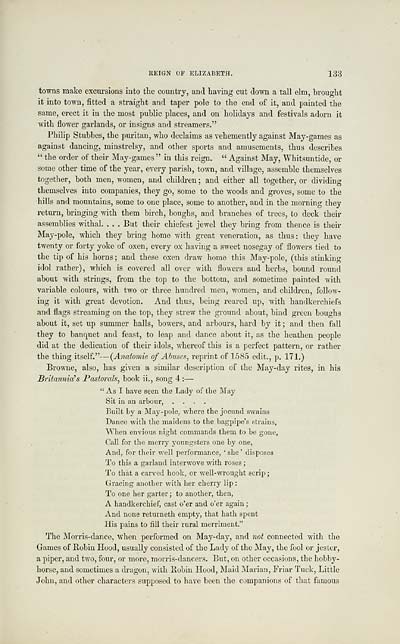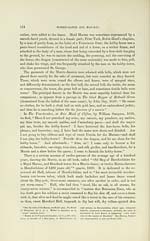Glen Collection of printed music > Printed text > Popular music of the olden time > Volume 1
(167) Page 133
Download files
Complete book:
Individual page:
Thumbnail gallery: Grid view | List view

EEIGN OF ELIZABETH. 133
towns make excursions into the country, and having cut down a tall elm, brought
it into town, fitted a straight and taper pole to the end of it, and painted the
same, erect it in the most public places, and on holidays and festivals adorn it
with ilower garlands, or insigns and streamers."
Philip Stubbes, the puritan, who declaims as vehemently against May-games as
against dancing, minstrelsy, and other sports and amusements, thus describes
" the order of their May-games " in this reign. " Against May, Whitsimtide, or
some other time of the year, every parish, town, and village, assemble themselves
together, both men, women, and chilch-en ; and either all together, or dividing
themselves into companies, they go, some to the woods and groves, some to the
hills and mountains, some to one place, some to another, aud in the morning they
return, bringing with them birch, boughs, and branches of trees, to deck their
assemblies withal. . . . But their chiefest jewel they bring from thence is their
May-pole, which they bring home with great veneration, as thus: they have
twenty or forty yoke of oxen, every ox having a sweet nosegay of flowers tied to
the tip of his horns ; and these oxen di-aw home this May-pole, (this stinking
idol rather), which is covered all over with flowers and herbs, boimd round
about with strings, from the top to the bottom, and sometime painted with
variable colours, with two or three hundred men, women, and children, follow-
ing it with great devotion. Aud thus, being reared up, with handkerchiefs
and flags streaming on the top, they strew the ground about, bind green boughs
about it, set up summer halls, bowers, and arbours, hard by it ; and then fall
they to banquet and feast, to leap and dance about it, as the heathen people
did at the dedication of their idols, whereof this is a perfect pattern, or rather
the thing itself." — (Anatomie of Abuses, reprint of 1585 edit., p. 171.)
Browne, also, has given a similar description of the May-day rites, in his
Britannia^ s Pastorals, book ii., song 4 : —
" As I have seen the Lady of the May
Sit ill an arbour, ....
Built by a May-pole, where the jocund swains
Dance with the maidens to the bagpipe's strains.
When envious night commands them to be gone,
Call for the merry youngsters one by one,
And, for their well jierformance, ' she ' disposes
To this a garland interwove with roses ;
To that a carved hook, or well-wrought scrip ;
Gracing another with her cherry lip :
To one her garter ; to another, then,
A handkerchief, cast o'er and o'er again ;
And none returneth empty, that hath spent
His pains to fill their rural merriment."
The Morris-dance, when performed on May-day, and not connected with the
Games of Robin Hood, usually consisted of the Lady of the May, the fool or jester,
a piper, and two, fom*, or more, morris-dancers. But, on other occasions, the hobby-
horse, and sometimes a dragon, with Robin Hood, Maid Marian, Friar Tuck, Little
John, and other characters supposed to have been the companions of that famous
towns make excursions into the country, and having cut down a tall elm, brought
it into town, fitted a straight and taper pole to the end of it, and painted the
same, erect it in the most public places, and on holidays and festivals adorn it
with ilower garlands, or insigns and streamers."
Philip Stubbes, the puritan, who declaims as vehemently against May-games as
against dancing, minstrelsy, and other sports and amusements, thus describes
" the order of their May-games " in this reign. " Against May, Whitsimtide, or
some other time of the year, every parish, town, and village, assemble themselves
together, both men, women, and chilch-en ; and either all together, or dividing
themselves into companies, they go, some to the woods and groves, some to the
hills and mountains, some to one place, some to another, aud in the morning they
return, bringing with them birch, boughs, and branches of trees, to deck their
assemblies withal. . . . But their chiefest jewel they bring from thence is their
May-pole, which they bring home with great veneration, as thus: they have
twenty or forty yoke of oxen, every ox having a sweet nosegay of flowers tied to
the tip of his horns ; and these oxen di-aw home this May-pole, (this stinking
idol rather), which is covered all over with flowers and herbs, boimd round
about with strings, from the top to the bottom, and sometime painted with
variable colours, with two or three hundred men, women, and children, follow-
ing it with great devotion. Aud thus, being reared up, with handkerchiefs
and flags streaming on the top, they strew the ground about, bind green boughs
about it, set up summer halls, bowers, and arbours, hard by it ; and then fall
they to banquet and feast, to leap and dance about it, as the heathen people
did at the dedication of their idols, whereof this is a perfect pattern, or rather
the thing itself." — (Anatomie of Abuses, reprint of 1585 edit., p. 171.)
Browne, also, has given a similar description of the May-day rites, in his
Britannia^ s Pastorals, book ii., song 4 : —
" As I have seen the Lady of the May
Sit ill an arbour, ....
Built by a May-pole, where the jocund swains
Dance with the maidens to the bagpipe's strains.
When envious night commands them to be gone,
Call for the merry youngsters one by one,
And, for their well jierformance, ' she ' disposes
To this a garland interwove with roses ;
To that a carved hook, or well-wrought scrip ;
Gracing another with her cherry lip :
To one her garter ; to another, then,
A handkerchief, cast o'er and o'er again ;
And none returneth empty, that hath spent
His pains to fill their rural merriment."
The Morris-dance, when performed on May-day, and not connected with the
Games of Robin Hood, usually consisted of the Lady of the May, the fool or jester,
a piper, and two, fom*, or more, morris-dancers. But, on other occasions, the hobby-
horse, and sometimes a dragon, with Robin Hood, Maid Marian, Friar Tuck, Little
John, and other characters supposed to have been the companions of that famous
Set display mode to: Large image | Transcription
Images and transcriptions on this page, including medium image downloads, may be used under the Creative Commons Attribution 4.0 International Licence unless otherwise stated. ![]()
| Special collections of printed music > Glen Collection of printed music > Printed text > Popular music of the olden time > Volume 1 > (167) Page 133 |
|---|
| Permanent URL | https://digital.nls.uk/91369451 |
|---|
| Shelfmark | Glen.254 |
|---|---|
| Additional NLS resources: | |
| Attribution and copyright: |
|
| Description | Scottish songs and music of the 18th and early 19th centuries, including music for the Highland bagpipe. These are selected items from the collection of John Glen (1833 to 1904). Also includes a few manuscripts, some treatises, and other books on the subject. |
|---|
| Description | The Glen Collection and the Inglis Collection represent mainly 18th and 19th century Scottish music, including Scottish songs. The collections of Berlioz and Verdi collected by bibliographer Cecil Hopkinson contain contemporary and later editions of the works of the two composers Berlioz and Verdi. |
|---|

